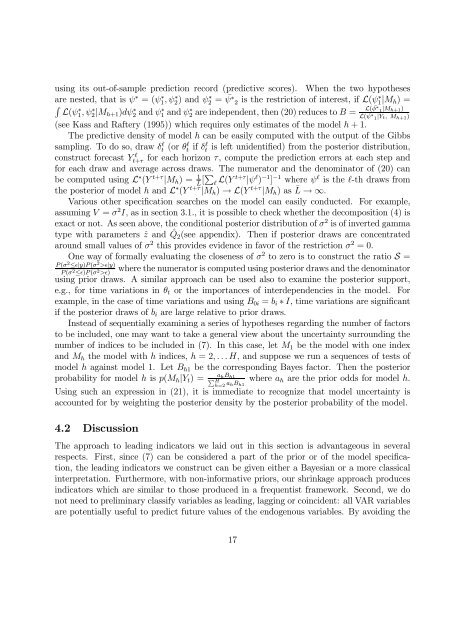PANEL INDEX VAR MODELS: SPECIFICATION, ESTIMATION - Ivie
Create successful ePaper yourself
Turn your PDF publications into a flip-book with our unique Google optimized e-Paper software.
using its out-of-sample prediction record (predictive scores). When the two hypotheses<br />
are nested, that is ψ ∗ =(ψ1, ∗ ψ2)andψ ∗ 2 ∗ = ¯ψ ∗ 2 is the restriction of interest, if L(ψ1|M ∗ h )=<br />
<br />
L(ψ<br />
∗<br />
1 , ψ2|M ∗ h+1 )dψ2 ∗ and ψ1 ∗ and ψ2 ∗ are independent, then (20) reduces to B =<br />
L( φ ¯∗<br />
1 |M h+1)<br />
L( ψ ¯∗<br />
1 |Y t,M h+1 )<br />
(see Kass and Raftery (1995)) which requires only estimates of the model h +1.<br />
The predictive density of model h can be easily computed with the output of the Gibbs<br />
sampling. Todoso,drawδt (or θt if δt is left unidentified) from the posterior distribution,<br />
construct forecast Yt+τ for each horizon τ, compute the prediction errors at each step and<br />
for each draw and average across draws. The numerator and the denominator of (20) can<br />
be computed using L ∗ (Y t+τ |M h )= 1¯L [ L(Y t+τ |ψ ) −1 ] −1 where ψ is the -th draws from<br />
the posterior of model h and L ∗ (Y t+τ |M h ) → L(Y t+τ |M h )as¯L →∞.<br />
Various other specification searches on the model can easily conducted. For example,<br />
assuming V = σ 2 I, as in section 3.1., it is possible to check whether the decomposition (4) is<br />
exact or not. As seen above, the conditional posterior distribution of σ 2 is of inverted gamma<br />
type with parameters ẑ and ˆQ 2 (see appendix). Then if posterior draws are concentrated<br />
around small values of σ 2 this provides evidence in favor of the restriction σ 2 =0.<br />
One way of formally evaluating the closeness of σ 2 to zero is to construct the ratio S =<br />
P (σ 2 ≤|y)P (σ 2 >|y)<br />
where the numerator is computed using posterior draws and the denominator<br />
P (σ 2 ≤)P (σ 2 >)<br />
using prior draws. A similar approach can be used also to examine the posterior support,<br />
e.g., for time variations in θ t or the importances of interdependencies in the model. For<br />
example, in the case of time variations and using B 0i = b i ∗ I, time variations are significant<br />
if the posterior draws of b i are large relative to prior draws.<br />
Instead of sequentially examining a series of hypotheses regarding the number of factors<br />
to be included, one may want to take a general view about the uncertainty surrounding the<br />
number of indices to be included in (7). In this case, let M 1 be the model with one index<br />
and M h the model with h indices, h =2,...H, and suppose we run a sequences of tests of<br />
model h against model 1. Let B h1 be the corresponding Bayes factor. Then the posterior<br />
probability for model h is p(M h |Y t )= a hB h1<br />
Hh=2 where a<br />
a h B h are the prior odds for model h.<br />
h1<br />
Using such an expression in (21), it is immediate to recognize that model uncertainty is<br />
accounted for by weighting the posterior density by the posterior probability of the model.<br />
4.2 Discussion<br />
The approach to leading indicators we laid out in this section is advantageous in several<br />
respects. First, since (7) can be considered a part of the prior or of the model specification,<br />
the leading indicators we construct can be given either a Bayesian or a more classical<br />
interpretation. Furthermore, with non-informative priors, our shrinkage approach produces<br />
indicators which are similar to those produced in a frequentist framework. Second, we do<br />
not need to preliminary classify variables as leading, lagging or coincident: all <strong>VAR</strong> variables<br />
are potentially useful to predict future values of the endogenous variables. By avoiding the<br />
17

















